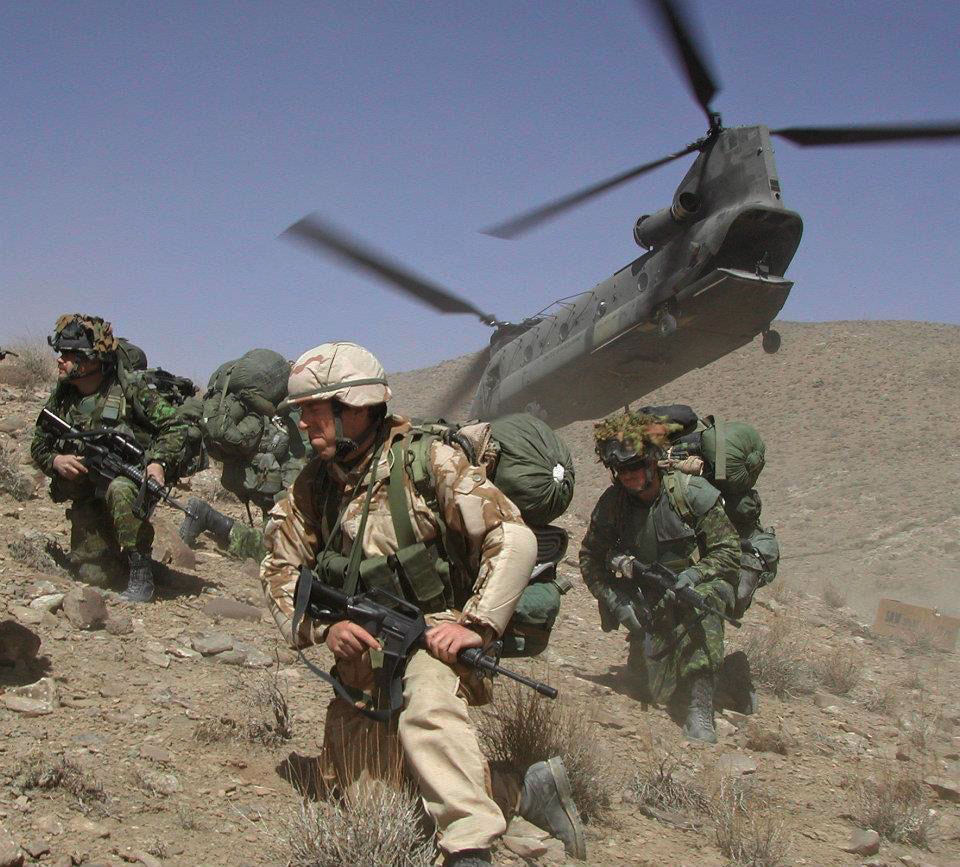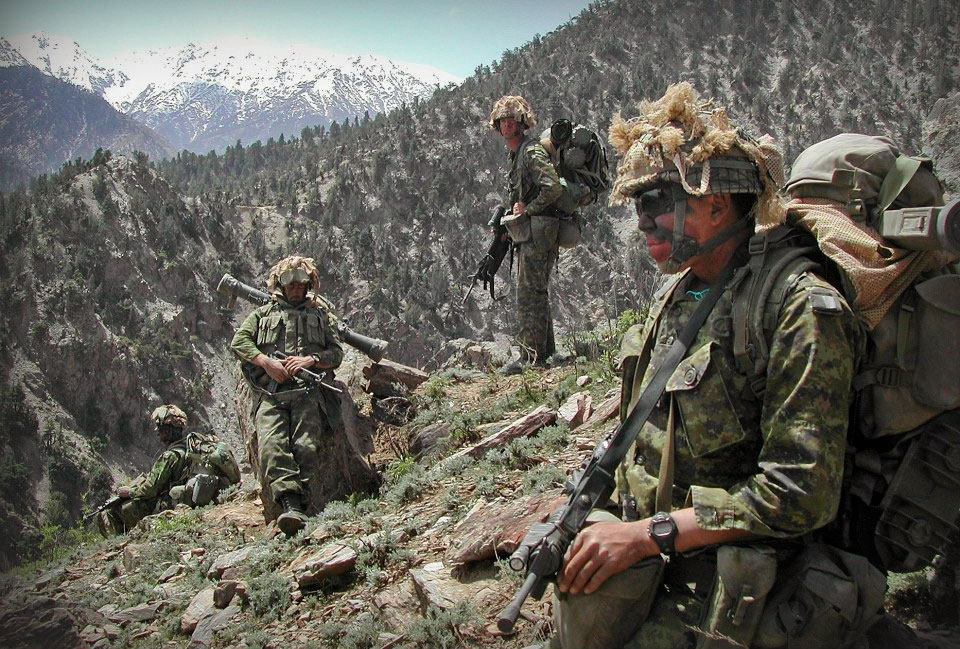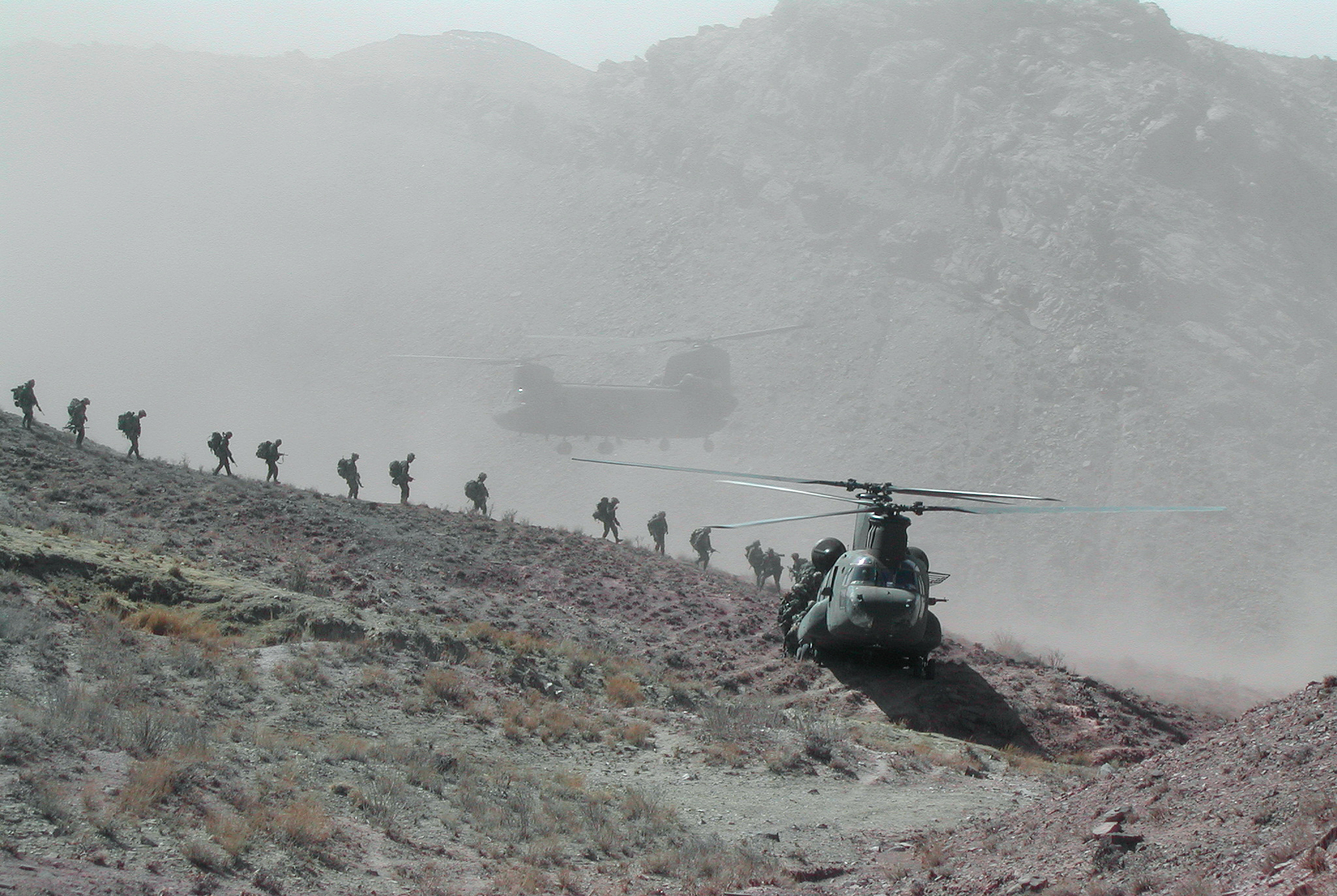
Reconnaissance troops and a sniper in British kit from 3rd Battalion, Princess Patricia’s Canadian Light Infantry, launch Canada’s first combat assault since the Korean War, on a mountain in eastern Afghanistan called The Whale’s Back on March 13, 2002. [Stephen J. Thorne/The Canadian Press]
Relatively stable over centuries of warfare, soldiers’ loads have increased significantly in the past three decades, due largely to new combat technologies and the batteries required to operate them.
Alleviating the burdens soldiers carry is a matter of life and death, researcher Linda Bossi told Legion Magazine.
“There is no way for us to know how many people became casualties because they were overloaded,” said Bossi, a defence scientist who has been studying the issue since 1993. “We do know from a series of studies that weight matters.”
Every kilogram of added weight increases physiological strain, energy expenditure, risk of injury and heat illness, possibly impairing a soldier’s ability to interpret threats or understand orders, thus increasing overall risk and vulnerability to enemy action.
“The more you carry, the slower you are; the slower you are, the more vulnerable you are to enemy action,” Bossi said in an interview. “Being slowed down means you are more likely to be detected, targeted and hit by the enemy.”
One of the first casualties of Canada’s first-ever helicopter-borne assault came on a mountain in Eastern Afghanistan in March 2002, where a machine-gunner carrying some 50 kilograms of arms, equipment and life-sustaining supplies blew out her knee disembarking from the helicopter that had just deposited her platoon. She was put back on board and evacuated before her operation even began.
In the paper Rationalizing the Approach to Mitigate Soldier Physical Burden: Are Iron Man or Captain America the Magic Bullet?, Bossi and her colleagues report, “the loads carried by soldiers today are at record highs.”
Technological innovation, she writes, “is more likely to have added to the soldier’s load than reduced it.”
In addition to armour, food, water, weapons and ammunition, soldiers now carry radios, global positioning systems, night-vision equipment, weapon-mounted sensing devices, aiming and illumination aids, underslung grenade launchers and breaching or jamming equipment.
“Most of these new capabilities require power,” she writes, “and since batteries are not standardized across equipment procurements, soldiers must now carry and manage multiple types of batteries, adding to their burden.”
Batteries alone can add more than nine kilograms to a soldier’s load, U.S. Army Major James King reported last year in a paper for the Modern War Institute at West Point entitled The Overweight Infantryman. He urged adoption of standardized batteries rechargeable by small solar panels.

General George C. Marshall, the eventual U.S. state and defence secretary famous for his post-Second World War plan to help rebuild Europe, once described the infantry soldier as a beast of burden whose chief function in war does not begin until he delivers his load on the objective.
Dating from the ironclad armies of Assyrian King Sargon II bearing shields, swords and spears in the 8th century BC, soldiers’ marching loads consistently averaged in the neighbourhood of 30 kilograms, or 30 per cent of body weight.
Slaves eased the burdens of Greek infantry soldiers a century later. Roman General Gaius Marius followed with sweeping reforms around 100 BC, among them an order to limit pack animals to one mule per 50 soldiers.
A mule, however, could only bear about 113.5 kilograms so, assuming the animals weren’t all loaded with their own feed, each soldier could shed only 2.5 kilograms. Roman infantrymen thus became known as Muli Mariani, or Marius Mules, much as U.S. marines in Vietnam came to be known as grunts almost two millennia later.
The Romans averaged 27.5 to 36.5 kilograms a man, while the Americans in Vietnam were at 27.5 to 32.
“The native Vietnamese were not so encumbered,” observes Australian researcher Rob Marc Orr in his paper The History of the Soldier’s Load. He pegs their average load to a mere 12 kilograms, chalking it up to home-field advantage.
Bossi notes in her paper, one of dozens she has written on the issue of loads, ergonomics and related matters, that military limits as a percentage of weight for mules and horses—actual beasts of burden—are typically capped at less than those of soldiers.
Mules and horses, she points out, are further benefited by the fact that, “unlike soldiers, [they] are not required to go into battle when they have delivered their loads to their objective.”
The battlefield dominance of actual horse-powered cavalry was relatively brief in the annals of history. Orr says the longbow, crossbow and ultimately powdered weapons thrust the foot soldier back into prominence, culminating with the widespread and devastating use of the machine gun in the First World War.
The advent of the combustion engine also shifted loads, though trucks and other vehicles were limited to roadways, restricting the movement and tactics of infantry.
The farther conquering soldiers ventured from home, it seems, the longer their marches were and the greater the burden their loads would become.

Members of 3rd Battalion, Princess Patricia’s Canadian Light Infantry, in Tora Bora, Afghanistan in May 2002. [Stephen J. Thorne/The Canadian Press]
“Our emperor makes war not with our arms but with our legs,” his weary troops would say.
By contrast, Union soldiers in the U.S. Civil War averaged between 20.5 and 22.5 kilograms each, while limited supplies and laxer regulations meant their Confederate opponents who, more often than not, were fighting on their own turf, carried considerably less.

Loads began creeping back up in the First World War, reducing the marching ability of the average soldier and, as a result, altering the tactics of war, Orr writes. Canadian soldiers were typical, carrying loads of up to 36 kilograms per man.
In the Second World War, individual loads of up to 41 kilograms were blamed for the drowning deaths of many Americans on Normandy’s Omaha Beach. Canadian and British troops carried similar burdens on D-Day.
“Even if the soldiers made it to the beach,” writes Orr, “they faced another problem: getting across the beach quickly and under intense enemy fire.
“Again, weight was against the soldiers as ‘the GIs were so laden with ammunition and equipment that every step was a strain.’”
In the Pacific, Japanese machine-gun units carried up to 56 kilograms a man, or 105 per cent of a typical Japanese soldier’s body weight.
Orr analyzes the loads soldiers carried in virtually every major conflict. He traces a jump in their burdens to the Falklands War in 1982, where British troops packed as much as 66 kilograms, while U.S. Army Rangers bore up to 76 kilograms a year later in Grenada.

Canadian troops board American Chinook helicopters at the end of Operation Harpoon on The Whale’s Back in eastern Afghanistan on March 17, 2002. Some were carrying loads of 60 kilograms. [Stephen J. Thorne/The Canadian Press]
Part of the problem was created by the nature of counter-insurgency operations, which can delay resupply, thus boosting the food, water, batteries and ammunition carried by troops who lacked confidence—justifiably so or not—in the next helicopter arriving as scheduled.
In some cases, Canadian loads in Afghanistan reached 65 per cent of body weight, well exceeding the recommended maximum, she writes in the paper, which is to be published in the coming book Transhumanising War: Performance Enhancement and the Implications for Policy, Society, and the Soldier.
Soldiers are more often than not ill-trained for such heavy humping, rarely entering theatre having prepared with “loads representative of those carried on operations.” To make matters worse, they often overload themselves as a precaution.
The single greatest contributor to a soldier’s load is ammunition, notes Bossi, “yet among the hundreds queried, only one soldier ever expended…their full load of ammunition. Similarly, no one had ever heard of a failure to resupply.”
Overload is a problem that permeates the military through planning, training and execution of combat operations. Bossi and others are now conducting intensified research. She recently consulted in Ottawa on the issue with non-commissioned officers from across the country.
“Burden mitigation should be a research and development priority,” said Bossi. “Research has not always reflected the extreme loads and conditions…reflective of operational reality.”
—
Next week, in Part 2 of this two-part series: Iron Man or Captain America? What will it take to solve the growing problem of soldiers’ loads?
Advertisement





















